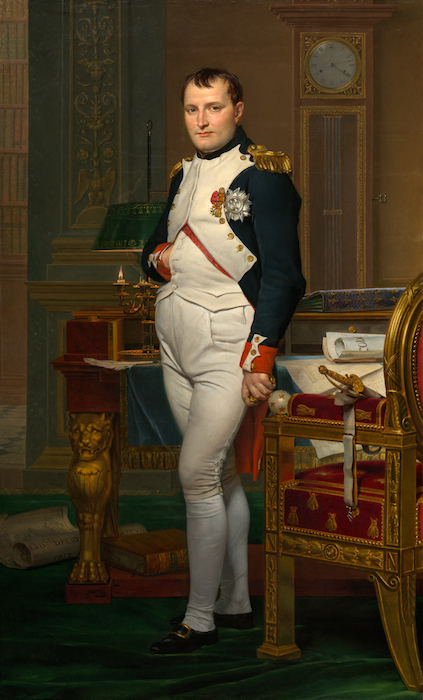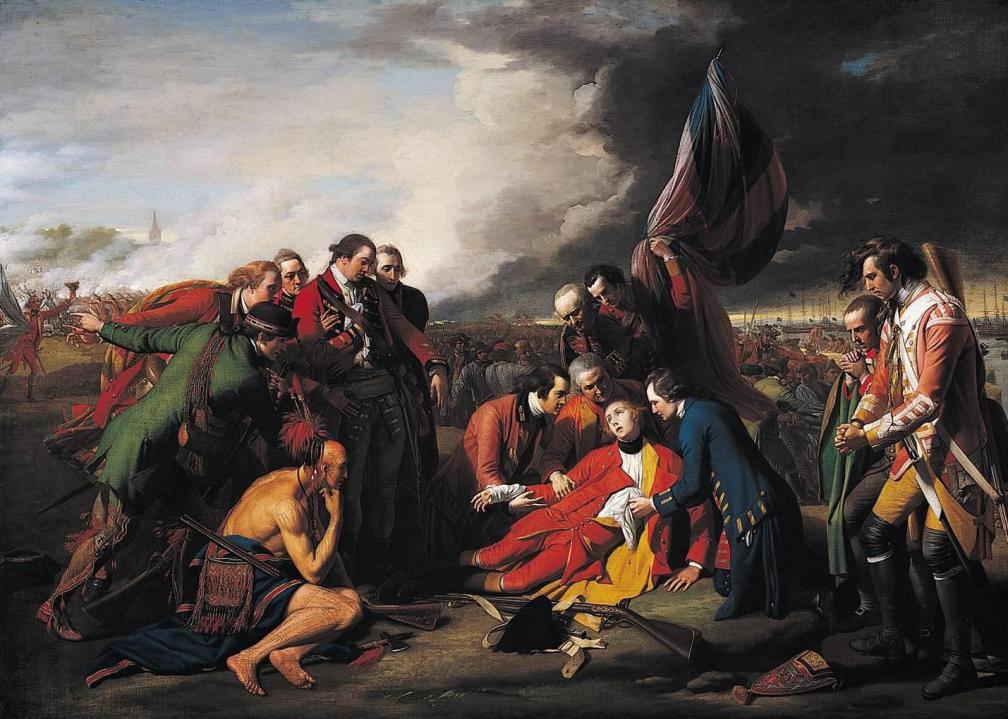The 1700’s were a century that came with many changes; namely the French and American revolutions, for this discussion. Classical Art also emerged from the 1700’s, and while American history was being made, their artistic community was not as prevalent as the artistic force that had been long since growing in Europe. Nevertheless, the happenings in America, and later France, inspired many new pieces of art that are still prominent today.

While this particular piece, “The Emperor Napoleon in his Study at the Tuileries,” was actually created in 1812, Jacques-Louise David was a prominent artist from the mid 1700’s to the early 1800’s, and gained a reputation that would tie him to the French Revolution at the end of his life. David and Napoleon had met briefly in 1798, and when Napoleon appointed himself emperor of France in 1804, David was named the “First Painter to the Emperor.” (Metropolitan Museum of Art)
This work has incorporated many subtle features that point to Napoleon’s courageousness and readiness for actions. We see a rolled up sheet up paper marked, “COD” on his chair – this is supposed to be the French Civil Code, also known as Code Napoleon. There is also a half unraveled map off to the side, a sword waiting at the ready next to him, and a lion finial (decorative bit of carving in the desk), which are meant to display Napoleon as the “fearless leader.” (National Gallery of Art)
David and his several pupils that were employed by Napoleon produced many pieces of work, and many pieces of propaganda, while he was in power. However, when the French monarchy regained power in 1815, David and many others were exiled to Brussels. David died in Brussels in 1825.

Jean Antoine Houdon was another artist who found inspiration aplenty from the revolutions going on around him. This, Houdon’s “George Washington” sculpture, was commissioned by Thomas Jefferson, being a dependable liaison for America in Europe in 1784 and there being very few art choices in America, in order to commemorate the successful conclusion of the American Revolutionary War. (Khan Academy)
This sculpture was a big milestone to Houdon – as well as the other portraits that he produced for well respected and reputable Americans such as Benjamin Franklin, John Paul Jones, and Thomas Jefferson. These works, in the midst of a time when the States were eager to celebrate their victory and commemorate the import figures that contributed to that victory, brought Houdon quite a bit of fame in America. (Metropolitan Museum of Art)
Houdon traveled to Virginia in order to take measurements for his sculpture of Washington, though he had also hoped to produce a larger than life size monument of Washington on horseback; unfortunately this never came to fruition. However, while he remained in America he continued to find work and produce busts of notables within society. When he returned to Europe from America, he was able to wed a well-educated and well-connected woman, and continue to take commissions for busts of notable Revolutionaries, including Napoleon in 1806. (Metropolitan Museum of Art)

“The Death of General Wolfe,” 1770 by Benjamin West was another important detour from the norm. On one hand, most previous historical paintings were based off of Biblical stories or classic stories from the past, and on another hand West was strongly urged to draw Wolfe and company in classical garb, to add to the “timeless heroism” that was to be captured. West however stated, “the same truth that guides the pen of the historian should govern the pencil [paintbrush] of the artist.” (Khan Academy)
This is, arguably, the painting that set the stage for the many “contemporary historic” paintings that would follow during this period. Artists John Singleton Copley and John Trumbull followed suit and composed numerous paintings of the same style throughout the rest of the 18th century.
Works Cited
The Emperor Napoleon in His Study at the Tuileries. http://www.nga.gov/Collection/highlights/highlight46114.html.
“The Legacy of Jacques Louis David (1748–1825).” Metropolitan Museum of Art, http://www.metmuseum.org/toah/hd/jldv/hd_jldv.htm.
I really enjoy the bright colors that are used in the two paintings you showed here. They do a good job of depicting royalty and heroic acts. The Death of General Wolfe is a perfect example of, what was at the time, a modern application of classical ideals. IT depicts a heroic act, a selfless sacrifice, a dramatic event portrayed at climax (or in this case many different parts of an event all depicted at once). The connection between West’s work and Copley’s and Trumbull’s is strikingly similar. I really am drawn towards these classical pieces, I think in part that they are rich in color and also rich in history. I’m not a history buff but I appreciate it. The contrast of lights and darks draw out the emotional response.
LikeLike
You have selected great pieces of art for your Classical blog post. I especially enjoy The Emperor Napoleon in His Study at the Tuileries. I am intrigued by the meticulous detail of Napoleon’s uniform and his surroundings; the darkness of the background in contrast with the lightness of his tall figure, placed in the center of the piece and commanding full attention. It is said that David’s intension with this painting of Napoleon, as described in a letter to the patron of the portrait, Alexander Douglas, is designed to depict his appearance as if he had spent the night in his study composing the Napoleon Code (“The Emperor”). Aspects such as his relaxed posture, disheveled hair, the flickering candles that are nearly extinguished, and the papers that are spread across the desk and floor further enforce this idea.
“The Emperor Napoleon in His Study at the Tuileries.” National Gallery of Art, https://www.nga.gov/Collection/art-object-page.46114.html. Accessed 25 Oct. 2017.
LikeLike
I really like the pieces you chose, they are great. I also like how you took each piece and related them to the era. I would not personally own any of these or own a copy of them, they belong in museums. I do like the colors in each piece though, especially the color in The Death of General Wolfe, there is so much shadowing and vibrancy in the artwork. It really tells a story. It shows that they are all coming together in this hard time. I also like that the skies are seeming to start to gray, almost as if it was a sad day for the world to lose him. I like how each piece tells a story and each piece is also very original at the same time. I am not nessicarily drawn to any piece but they are all great and meaningful.
LikeLike
All three works of art you displayed on your blog capture a moment in time, a telltale sign on neoclassicism. These paintings and sculpture show what was important or well-respected during this time period- heroism. All three pieces display men who had fought for their country. In earlier pieces, we see art that is lavish or depicts mythologies or stories from the bible, but these works of art focus on what was happening then in time. Nothing romantic about it, very straightforward art that shows courage and moral virtues such as heroism. It is interesting to see the major shift in what was popular for art in this time period. I enjoy these pieces, and I would love to see them in person one day, but I would not want to own them.
LikeLike